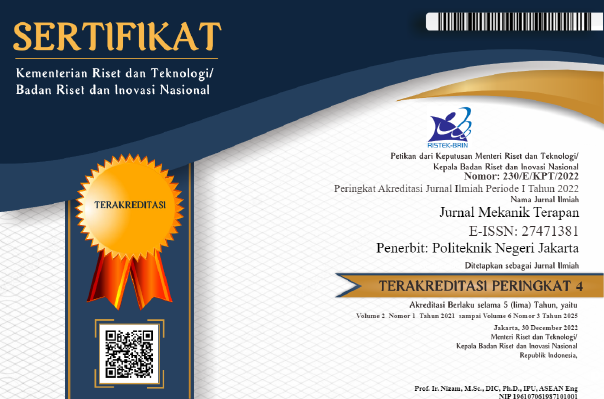Prototipe Penahan Banjir dengan Menggunakan Material Daur Ulang (PET)
DOI:
https://doi.org/10.32722/jmt.v4i1.5790Keywords:
Analisa kerusakan, mesin milling, cutter frais, patahan dan keausanAbstract
Failure studies on the F4.04 milling machine cutter that frequently occur in the manufacturing industry have been conducted using applied failure analysis and repair methods. This study aims to analyze the damage to the F4.04 milling machine cutter and carry out repairs according to existing standards. The analysis of the root causes of damage and appropriate repairs is expected to enhance efficiency, productivity, and reduce production costs in the manufacturing industry. This analysis describes the results of visual observations of damage to the cutter in the form of fractures at the edges and surface wear. Fractures at the cutter edges appear irregularly, caused by excessive cutting loads. Excessive cutting loads result from improper feed speeds and excessive cutting depths. Process instability also contributes to cutter damage. Excessive vibration in the milling machine generates impacts or collisions that damage the cutter and accelerate wear. Excessive cutting loads and cutting instability are initiated by damage to bearing components and the use of non-standard V-belt sizes. This study provides a better understanding of the types of cutter damage and influencing factors, which can be utilized to enhance cutting efficiency and cutter lifespan. It is expected that this study will contribute to identifying the exact causes of damage and designing appropriate repairs, thereby improving production quality, and reducing the risk of damage to F4.04 milling machines in the future.
References
L. . Rachmawati, A. . Latifa, H. . Yogaswara, and . F. ., “Persepsi Risiko Dan Komunikasi Risiko Bencana Banjir Jakarta,” Pros. Geoteknologi Lipi, vol. 1, no. 0, 2014.
A. S. G. Group, “Inventor,” 2022. [Online]. Available: https://www.asti.com/product/inventor/. [Accessed: 06-Oct-2022].
M. Gupta, “Morphological Matrix,” Morphological Matrix, 2020. [Online]. Available: https://www.benchmarksixsigma.com/forum/topic/36191-morphological-matrix/.
A. Klippe, “The Real Danger in Flood EXPOSED (And a Tip to be Protected),” The Real Danger in Flood EXPOSED (And a Tip to be Protected), 2017. [Online]. Available: https://floodcontrol.asia/expert-blog/real-danger-flood-exposed/#:~:text=A 1-meter floodwater exerts,exerts amounts to 19.6 kPa. [Accessed: 06-Oct-2022].
Downloads
Published
How to Cite
Issue
Section
License
Copyright (c) 2023 Mirwan Nabil, Syarir Akram Bin Jamaluddin

This work is licensed under a Creative Commons Attribution-ShareAlike 4.0 International License.
Jurnal ini berlisensi Atribut Berbagi Serupa 4.0 Internasional (CC BY-SA 4.0)
Anda diperbolehkan:
- Berbagi — menyalin dan menyebarluaskan kembali materi ini dalam bentuk atau format apapun;
- Adaptasi — menggubah, mengubah, dan membuat turunan dari materi ini untuk kepentingan apapun, termasuk kepentingan komersial.
Berdasarkan ketentuan berikut:
-
Atribusi — Anda harus mencantumkan nama yang sesuai, mencantumkan tautan terhadap lisensi, dan menyatakan bahwa telah ada perubahan yang dilakukan. Anda dapat melakukan hal ini dengan cara yang sesuai, namun tidak mengisyaratkan bahwa pemberi lisensi mendukung Anda atau penggunaan Anda.
-
BerbagiSerupa — Apabila Anda menggubah, mengubah, atau membuat turunan dari materi ini, Anda harus menyebarluaskan kontribusi Anda di bawah lisensi yang sama dengan materi asli.
- Tidak ada pembatasan tambahan — Anda tidak dapat menggunakan ketentuan hukum atau sarana kontrol teknologi yang secara hukum membatasi orang lain untuk melakukan hal-hal yang diizinkan lisensi ini.






